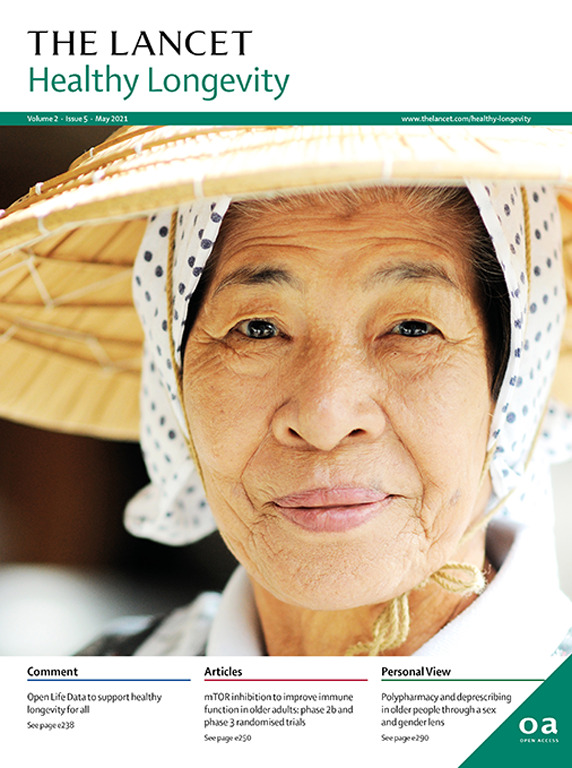年龄对血管危险因素与急性卒中(INTERSTROKE)关联的影响:一项病例对照研究。
IF 14.6
Q1 GERIATRICS & GERONTOLOGY
引用次数: 0
摘要
背景:由于人口老龄化,以及年轻人中风发病率的增加,卒中的绝对负担正在增加。在INTERSTROKE研究中,我们的目的是确定年龄是否会改变血管危险因素与中风之间的关联程度。方法:INTERSTROKE是一项针对首次急性卒中危险因素的国际病例对照研究。在32个国家(2007年1月11日至2015年8月8日)招募了病例和对照(按年龄和性别匹配)。参与者在招募后72小时内完成临床评估并提供血液和尿液样本。计算各年龄组血管危险因素及其人群归因分数(PAFs)的比值比(ORs)。我们测试了年龄与每个风险因素之间的相互作用。结果:在26950名参与者中,病例的平均年龄为66.2岁(标准差为13.6),对照组的平均年龄为63.1岁(标准差为13.3)。随着年龄的增长,7种血管危险因素(高血压、缺乏运动、糖尿病、心房颤动、高腰臀比、高载脂蛋白B浓度[p . interactioninteraction= 0.011]、饮酒(p . interactioninteraction= 0.033)的患病率显著增加。没有血管危险因素与随着年龄增长而增加的中风几率相关。高血压、高腰臀比和缺乏运动是所有年龄组中最大的PAF。解释:不同年龄的血管危险因素与中风的关联模式不同,其相对PAF也随之发生变化。这些信息可用于按年龄组优先筛选和修改风险因素。资助:加拿大卫生研究所;加拿大心脏和中风基金会;加拿大中风网络;爱尔兰健康研究委员会AFA保险;瑞典研究理事会;瑞典心肺基金会;区域执行局卫生和医疗保健委员会,Västra Götaland区域(瑞典);阿斯利康;勃林格殷格翰(加拿大);辉瑞(加拿大);默沙东公司;苏格兰的胸部、心脏和中风;和英国中风协会。本文章由计算机程序翻译,如有差异,请以英文原文为准。
Influence of age on the association of vascular risk factors with acute stroke (INTERSTROKE): a case–control study
Background
The absolute burden of stroke is increasing due to an ageing population, as well as an increased incidence of stroke in young adults. We aimed to determine whether age modifies the magnitude of association between vascular risk factors and stroke in the INTERSTROKE study.
Methods
INTERSTROKE is an international case–control study of risk factors for first acute stroke. Cases and controls (matched by age and sex) were recruited in 32 countries (between Jan 11, 2007, and Aug 8, 2015). Participants completed a clinical assessment and provided blood and urine samples within 72 h of recruitment. Odds ratios (ORs) for vascular risk factors and their population attributable fractions (PAFs) were calculated among age groups. We tested for an interaction of age by each risk factor.
Findings
Among 26 950 participants, the mean age of cases was 62·2 years (SD 13·6) and of controls 61·3 years (13·3). Increasing age was associated with a significant increased prevalence for seven vascular risk factors (hypertension, physical inactivity, diabetes, atrial fibrillation, high waist-to-hip ratio, high apolipoprotein B concentration [p<0·0001 for all], and obesity [p=0·016]), reduced prevalence for four vascular risk factors (smoking, alcohol use, psychosocial stress [p<0·0001 for all], and unhealthy diet [p=0·0081]) and unchanged prevalence for one vascular risk factor (depression). Increasing age was associated with a reduced magnitude of OR of stroke for hypertension (pinteraction<0·0001), high apolipoprotein B concentration (pinteraction<0·001), high waist-to-hip ratio (pinteraction 0·011), alcohol use (pinteraction<0·0001), and psychosocial stress (pinteraction=0·033). No vascular risk factor was associated with a higher odds of stroke with increased age. Hypertension, high waist-to-hip ratio, and physical inactivity accounted for the largest PAF among all age groups.
Interpretation
Vascular risk factors exhibit different patterns of association with stroke by age, with consequent variations in their relative PAF. This information could be used to prioritise risk factor screening and modification by age group.
Funding
Canadian Institutes of Health Research; Heart and Stroke Foundation of Canada; Canadian Stroke Network; AFA Insurance, Health Research Board Ireland; Swedish Research Council; Swedish Heart and Lung Foundation; The Health & Medical Care Committee of the Regional Executive Board, Region Västra Götaland (Sweden); AstraZeneca; Boehringer Ingelheim (Canada); Pfizer (Canada); MSD; Chest, Heart, and Stroke Scotland; and The UK Stroke Association.
求助全文
通过发布文献求助,成功后即可免费获取论文全文。
去求助
来源期刊

Lancet Healthy Longevity
GERIATRICS & GERONTOLOGY-
CiteScore
16.30
自引率
2.30%
发文量
192
审稿时长
12 weeks
期刊介绍:
The Lancet Healthy Longevity, a gold open-access journal, focuses on clinically-relevant longevity and healthy aging research. It covers early-stage clinical research on aging mechanisms, epidemiological studies, and societal research on changing populations. The journal includes clinical trials across disciplines, particularly in gerontology and age-specific clinical guidelines. In line with the Lancet family tradition, it advocates for the rights of all to healthy lives, emphasizing original research likely to impact clinical practice or thinking. Clinical and policy reviews also contribute to shaping the discourse in this rapidly growing discipline.
 求助内容:
求助内容: 应助结果提醒方式:
应助结果提醒方式:


